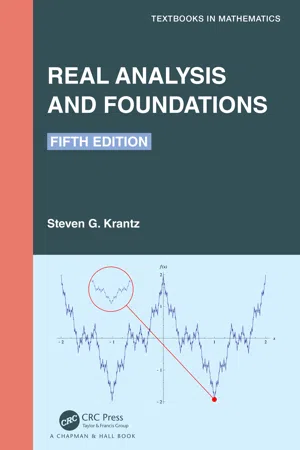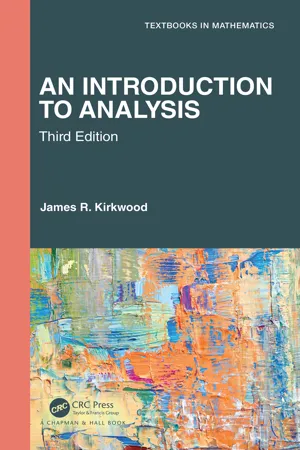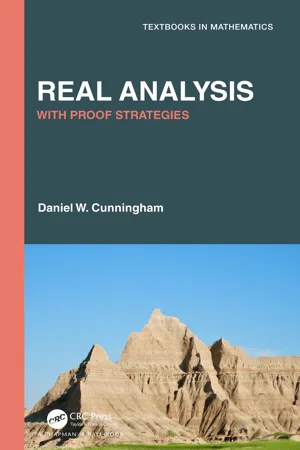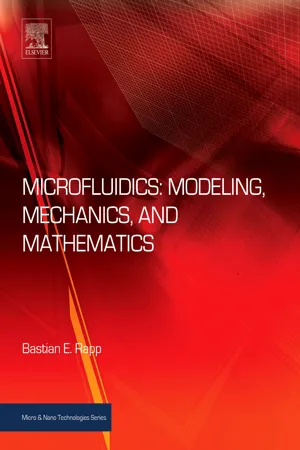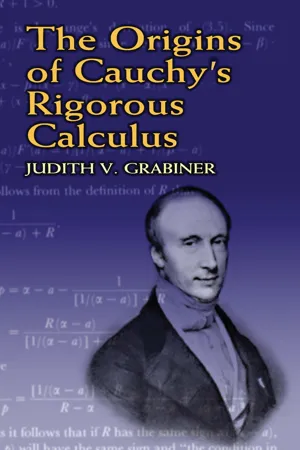Mathematics
Root Test
The Root Test is a convergence test used in calculus to determine whether a series converges or diverges. It involves taking the nth root of the absolute value of each term in the series and then taking the limit as n approaches infinity. If the limit is less than 1, the series converges; if it is greater than 1, the series diverges; and if it is equal to 1, the test is inconclusive.
Written by Perlego with AI-assistance
Related key terms
Related key terms
1 of 4
Related key terms
1 of 3
5 Key excerpts on "Root Test"
- eBook - ePub
- Steven G. Krantz(Author)
- 2022(Publication Date)
- Chapman and Hall/CRC(Publisher)
The result is lim sup n → ∞ | a n | 1 / n ≤ μ. Since μ < 1, we find that our series satisfies the hypotheses of the Root Test. Hence it converges. □ Remark 3.21: The proof of the Ratio Test shows that if a series passes the Ratio Test then it passes the Root Test (the converse is not true, as you will learn in Exercise 2). Put another way, the Root Test is a better test than the Ratio Test because it will give information whenever the Ratio Test does and also in some circumstances when the Ratio Test does not. Why do we therefore learn the Ratio Test? The answer is that there are circumstances when the Ratio Test is easier to apply than the Root Test. Example 3.22: The series ∑ j = 1 ∞ 2 j j ! is easily studied using the Ratio Test (recall that j ! ≡ j ⋅ (j − 1) ⋅ … 2 ⋅ 1). Indeed a j = 2 j / j ! and | a j + 1 a j | = 2 j + 1 / (j + 1) ! 2 j / j !. We can perform the division to see that | a j + 1 a j | = 2 j + 1. The lim sup of the last expression is 0. By the Ratio Test, the series converges. Notice that in this example, while the Root Test applies in principle, it would be difficult to use in practice. □ Example 3.23: We apply the Root Test to the series ∑ j = 1 ∞ j 2 2 j. Observe that a j = j 2 2 j hence that | a j | 1 / j = (j 1 / j) 2 2. As j → ∞, we see that lim sup j → ∞ | a j | 1 / j = 1 2. By the Root Test, the series converges. □ It is natural to ask whether the Ratio and Root Tests can detect divergence. Neither test is necessary and sufficient: there are series which elude the analysis of both tests. However, the arguments that we used to establish Theorems 3.19 and 3.20 can also be used to establish the following (the proofs are left as exercises): Theorem 3.24: (The Root Test for Divergence) Consider the series ∑ j = 1 ∞ a j of nonzero terms - eBook - ePub
- James R. Kirkwood(Author)
- 2021(Publication Date)
- Chapman and Hall/CRC(Publisher)
These two tests, the ratio test and the Root Test, will normally work only for series whose terms go to zero very rapidly. The reason is that series to which these tests apply to show convergence must be comparable to geometric series whose terms go to zero very rapidly. Notice this, as the proofs of these theorems are discussed. This is not to minimize their importance – they are among our most useful tests. Theorem 7.7 (Ratio Test): Let ∑ a n be a series of positive terms. Let R = lim ¯ a n + 1 a n and r = lim ¯ a n + 1 a n. Then the series ∑ a n converges if R < 1 and diverges if r > 1. Note: The test is inconclusive if r ≤ 1 ≤ R. Before writing a formal proof, we give the idea of the proof, which is to compare the series with a geometric series. Suppose that a n + 1 / a n = r for every n. Then a n + 1 = r a n for every n. Thus a 2 = r a 1 a 3 = r a 2 = r (r a 1) = r 2 a 1 a 4 = r a 3 = r (r 2 a 1) = r 3 a 1 ⋮ a n = r n − 1 a 1 so. that a 1 + a 2 + ⋯ + a n = a 1 + r a 1 + r 2 a 1 + ⋯ + r n − 1 a 1. That is, we have a geometric series that converges if r < 1 and diverges if r > 1. Proof: Let R = lim ¯ (a n + 1 / a n) and suppose that R < 1. We shall show that the series converges. In Theorem 2.17 we showed that there are only finitely many terms a n + 1 / a n larger than R + ϵ for any ϵ > 0. Choose ϵ = (1 − R) / 2, and let R 1 = R + ϵ. (See Figure 7.1.) Figure 7.1 See proof of Theorem 7.7. Then R 1 < 1 and a n + 1 / a n < R 1 for all but finitely many n. Thus there is a number N such that if n ≥ N then a n + 1 < R 1 a n. So a N + a N + 1 + a N + 2 + ⋯ < a N + a N R 1 + a N (R 1) 2 + ⋯. The series on the right is a convergent geometric series, since R 1 < 1. Thus, by the comparison test, the series on the left converges. Since adding a finite number of terms to a series does not affect its convergence, the original series converges. We now show that if r = lim ¯ (a n + 1 / a n) > 1, the series ∑ a n diverges - eBook - ePub
Real Analysis
With Proof Strategies
- Daniel W. Cunningham(Author)
- 2021(Publication Date)
- Chapman and Hall/CRC(Publisher)
k is conditionally convergent.7.2.5. The Ratio and Root Tests
As mentioned above, one may be able to use some of the tests already introduced to determine if a series converges absolutely. But these tests do not work for all series. In this section we shall derive two new tests which often prove to be useful in showing that a series is absolutely convergent. These tests are called the Ratio Test and the Root Test. These tests deal with the terms of a given series by measuring the rate at which the terms converge to 0. Of course, we know that if the terms of a series converge to 0, this does not imply that the series converges. However, the proofs of these new tests show that if this rate of decrease is comparable to that of a convergent geometric series, then this will ensure convergence.The Ratio TestThe Ratio Test measures the rate of decline of the terms of a seriesby investigating the long-term behavior of the ratioa 1,a 2, … ,a k, …|. If this rate is less than 1, then the series will converge. The proof of the test relies on the direct comparison test and a geometric series.|ak + 1a kTheorem 16. (Ratio Test I). Letbe a series of nonzero real numbers.∑k = 1∞a k- If there is real numberρ < 1and a natural number N such thatfor all|≤ ρ|ak + 1a kk ≥ N, then∑k =
- Bastian E. Rapp(Author)
- 2016(Publication Date)
- Elsevier(Publisher)
Chapter 4Series
4.1 Introduction
4.1.1 Definition
In general a seriessnis defined as a sum of a given number of termsaisuch thats n=a 1+a 2+ . . .a n=∑i = 1na iIf n = ∞ , the series is said to be infinite series . If n is finite, it is said to be a finite series .4.1.2 Convergence
In most practical applications, a series will have to be evaluated up to a given upper bound n . The higher this bound is chosen, the more exact the solution, but also the more time-consuming, complicated and computationally expensive the solution will become. Therefore a suitable trade-off for n must be found.However, some of the more important series actually sum up to a defined value. In such cases a series is said to be a convergent series . Obviously, convergent series are significantly easier to use as they can simply be replaced by the convergence value . The convergence value s is defined ass =limn → ∞∑i = 1na iCertain criteria can be used in order to test whether a series converges.Ratio Test. The ratio test checks iflimx → ∞|= q|an + 1a nIf q < 1, the series converges; for q > 1, the series diverges. For q = n , the test is inconclusive, i.e. , it makes no statement about whether or not the series converges.Root Test. The Root Test checks iflimnx → ∞|= qa n|For q < 1, the series converges; for q > 1, the series diverges. For q = n , the test is inconclusive, i.e. , it makes no statement about whether or not the series converges.Other Tests. Additional tests can be used to test a series for convergence. The interested reader may refer to standard textbooks on engineering mathematics for more details.4.1.3 Important Series
In the following sections, we will occasionally have to evaluate series. The most important ones are summarized in Tab. 4.1 together with their convergence values.Tab. 4.1- eBook - ePub
- Judith V. Grabiner(Author)
- 2012(Publication Date)
- Dover Publications(Publisher)
100Cauchy’s proof of the Root Test was followed by his statement and proof of the ratio test, again for series with positive terms: “If, for increasing values of n, the ratio un + l/un converges to a fixed limit k, the series will be convergent when k < 1, and divergent when k > l.”101 This test, unlike the Root Test, had already been used by others in special cases.Cauchy proved the ratio test in his Calcul infinitésimal by appealing, as d’Alembert had done for the case of the binomial series, to the comparison test with the geometric series.102 Cauchy gave a more elegant and novel proof of the ratio test, however in his Cours d’analyse, deducing it from the Root Test by means of this theorem: “If the series A1 , A2 , A3 … is such that the ratio of two consecutive terms, An + 1/An , converges constantly, for increasing values of n, to a fixed limit A, the expression (An )1/nconverges at the same time to the same limit.”103Cauchy concluded his treatment of series with positive terms by proving several other useful theorems. Most important, for series with positive terms he defined what is now called the Cauchy product of two series and proved, with a careful use of bounding inequalities, that it converges to the product of the separate sums. That is, ifand thenis a new convergent series whose sum is SS′.This result is clearly motivated by Cauchy’s concern with power series. In the eighteenth century, the Cauchy product had often been used in multiplying power series;104 Cauchy was the first not only to prove it but to specify the conditions for which it holds. And the proof is important for a reason more profound than its novelty. Products of infinite series were used, and the theorem assumed, even for power series that may have negative terms. Cauchy’s proof requires that the terms be positive; presumably he noticed this fact when he tried to prove the theorem for series of mixed signs. Eventually he proved the theorem only under the condition that the series of the absolute values of the terms converges—that is, in modern terms, is absolutely convergent. And he gave an example in which the Cauchy product of two series that are convergent, but not absolutely convergent, produce a divergent series—the first such example to be presented.105
Index pages curate the most relevant extracts from our library of academic textbooks. They’ve been created using an in-house natural language model (NLM), each adding context and meaning to key research topics.
Explore more topic indexes
Explore more topic indexes
1 of 6
Explore more topic indexes
1 of 4
